Heroes of the Environment NCERT Solutions | Communicative English for Class 10 PDF Download
B.1. Read the following Newspaper story:
Sherpa to clean Mount Everest
Mount Everest will be cleaned up, thanks to the efforts of twenty Nepali climbers who are setting off to remove decades-old garbage from the mountain.
The expedition, led by Namgyal Sherpa, will clean the area known as the "death zone." Sherpa stated: "This is the first time we are cleaning at that height, the death zone. It is very difficult and dangerous." The death zone gets its name from thin air, sub-freezing temperatures and extreme climbing conditions.
"The garbage was buried under snow in the past. But now it has come out on the surface because of the melting of snow due to global warming," the Sherpa said.
Many consider Everest to be the world's highest garbage dump. Some climbers leave behind their trash and gear such as climbing equipment, food, plastics, tins, aluminum cans, glass, clothes, paper, tents, and even dead bodies. 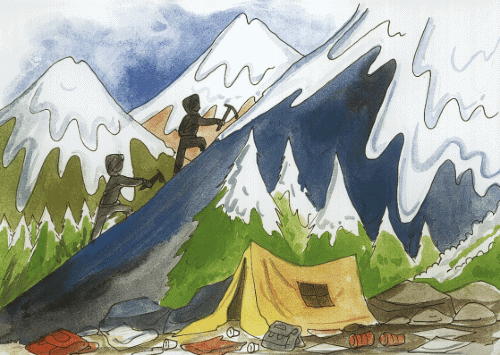 American Barry G. Bishop, upon his return from Mount Everest, labeled the mountain "the highest junkyard in the world." The team will attempt to remove at least 4,400 pounds of garbage during the expedition.
American Barry G. Bishop, upon his return from Mount Everest, labeled the mountain "the highest junkyard in the world." The team will attempt to remove at least 4,400 pounds of garbage during the expedition.
More than 4,000 climbers have reached Mount Everest's summit since it was first conquered. A special effort is being made to remove the body of a Swiss climber who died on the mountain in a 2008 climbing attempt.
The team's mission is the collection of waste to set an example for future climbers.
Ans: Sherpa to clean Mount Everest
B.2. On the basis of your reading of the news story, complete the following table after a group discussion.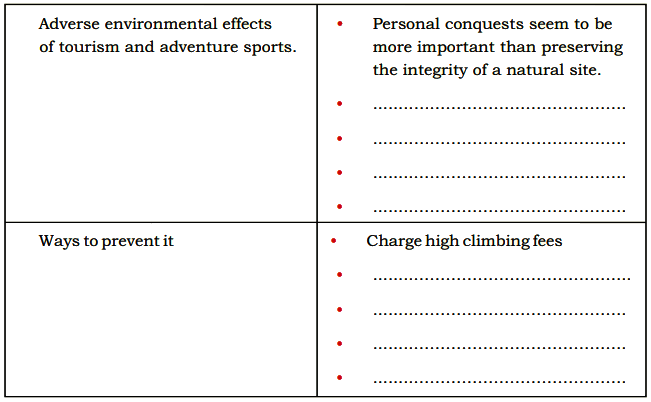
Ans:
(a) leaving behind trash and
(b) climbing equipment
(c) food containers, eg, tins, plastics, glass, clothes, tents
(d) dead bodies
(e) checking what is being carried and what is to be brought back after being used
(f) fixing personal responsibility for keeping the leftovers with the self
(g) charging high penalty for breaking rules framed
(h) banning climbing if found guilty of breach of rules.
B.3. Now imagine you are in charge of a Mountaineering Expedition to Mount Everest. You have to address the first time climbers. Write the instructions that you would give to the climbers on keeping the track clean besides giving instructions on safety measures. Instruct how they can contribute in preventing the Everest from becoming, “The highest junkyard in the world”.
Before writing the instructions, read the following questionnaire on how to write instructions and tick mark the right option:
1. What tense is commonly used in writing imperative sentences?
a. Present Continuous
b. Simple Past
c. Simple Present
2. Where do verbs most commonly come in these instructions ?
a. At the beginning of a sentence or a clause
b. In the middle of a sentence or a clause
3. How long are the sentences?
a. Very long
b. Mixed length
c. Short
4. Why are the instructions so written/given?
a. So that the reader can understand more easily
b. So that the writer can write more easily
5. What is the order of the instructions?
a. Mixed order
b. The order in which the instructions have to be carried out
6. Are the instructions numbered?
a. No
b. Yes
Ans:
- (c) Simple Present
- (a) At the beginning of a sentence or a clause
- (b) Mixed length
- (a) So that the reader can understand more easily
- (b) The order in which the instructions have to be carried out
- (b) Yes.
ADDRESS TO THE FIRST-TIME CLIMBERS
Gentlemen
Being Incharge of the Mountaineering Expedition to Mount Everest, I welcome you all to this world’s most arduous climb. I presume that you do not need any extra instructions, guidance and advice. However, I would expect you all to take a special care of a few things. These are like keeping the track clean and guarding yourself against eventual dangers. These safety measures as well as keeping the track clean will make the climb for the next generation an enjoyable adventure sport. First how to keep the track clean :
To keep the Track Clean :
- Don’t throw the trash on the track or to its sides.
- Plastics, food wrappers, empty tins, aluminium cans, glass, papers, etc, should be put in a separate bag and brought back.
- Anything that is not per: sh able should not be left behind. You know these things don’t rot and add to the spoiling of the place.
- Kitchen waste, if any, while cooking in the tents must also not be left on the track.
- Anything that adds to the ugliness of the place should not be thrown anywhere.
On Safety Measures :
- You know, safety counts the most important. Wear your woollen gear as per the specifications for climbing tie Everest.
- Take all the necessary equipments with you as per the climbing manual.
- Ropes, snow axes, knife, gloves etc, that form a part of the climbing equipment should be used very judiciously.
- Crevices in the snow may face you. Be very vigilant as it takes seconds to lose one’s life if one ignores them. Double check everything before starting the most difficult climb.
- Various gadgets like wireless sets, batteries and other communication equipments should be checked to be in perfect working order.
- Don’t forget to give an SOS in case you fall into a dangerous situation
How you can contribute in preventing the Everest from becoming ‘The Highest junkyard in the World’
I have already invited your attention on how to keep the track clean. You all must ensure that no wrappers of food items, tins, plastics, bottles, food items or leftovers of anything must be thrown. In fact, no trace that you ever pitched your tents should be seen. It is in your own hands to keep the track and Mount Everest neat, clean and unspoilt. The leftovers, if any, must be brought back down. I hope you’ll cooperate in this public cause.
Thanks a lot.
B.4. How to design a Poster?
Design a poster for promoting cleanliness in the surroundings of your colony
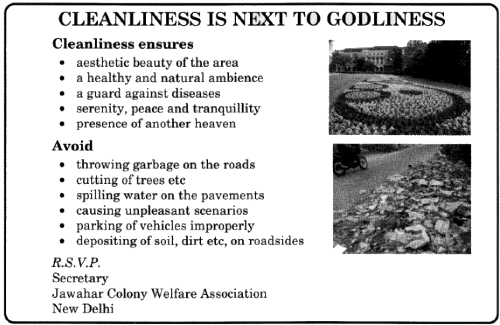
On the basis of this, design a poster urging mountaineers to preserve the pristine glory of the mountainsides. Work in groups of 4-5.
Ans: Students to design a poster on their own as directed. One version is given below :
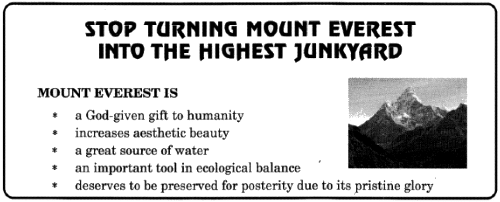
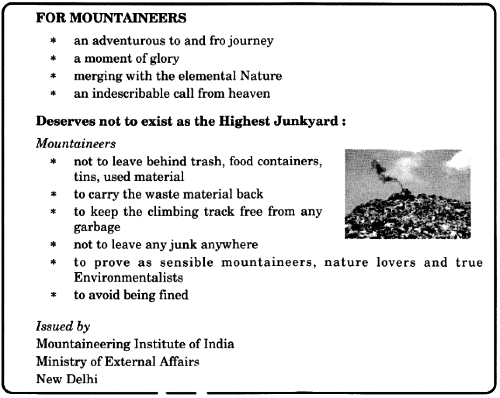
B.5. Wangari Maathai started the green Belt Movement and also fought for equal rights for women in Africa. She is the first African woman to win the Nobel Peace Prize. Read the excerpts from her interview with NHK Radio (Japan).
Ans: See the summary and word notes in the beginning of the chapter.
B.6. Based on your reading of Wangari Maathai's interview answer the following questions:
1. Complete the tree of environment:
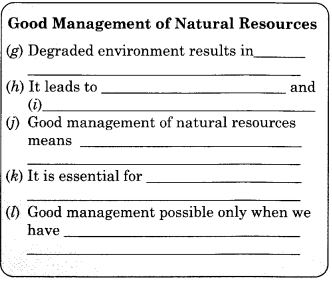 2. How does Wangari Maathai explain the essential components of development? Label and explain through the analogy of the stool.
2. How does Wangari Maathai explain the essential components of development? Label and explain through the analogy of the stool.
 3. What changes in the environment had Wangari Maathai noticed after growing up ?
3. What changes in the environment had Wangari Maathai noticed after growing up ?
4. What is the importance of indigenous flora and fauna ?
5. How did the campaign to save environment lead to the empowerment of women ?
6. What transformation did Wangari Maathai see in people and the environment ?
Ans:
1.
(a) food, firewood, building material, water
(b) the environment was degraded
(c) environment needed to be rehabilitated
(d) water, food etc
(e) climate change, lack of water, ground water not charging
(f) help in the rehabilitating of the forests
(g) loss of rain, climate change and change in weather patterns
(h) shortage of water
(i) a change of rainfall patterns
(J) supporting communities
(k) peace all over the world
(l) equitable distribution of natural resources
2.
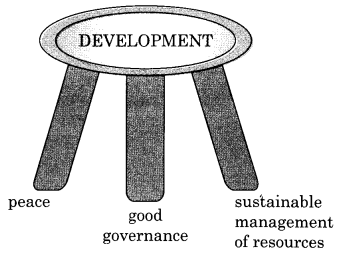
3. All the flora and fauna had disappeared. Forests which were the water towers were no longer able to contain the water. Weather patterns changed and rain became less.
4. Indigenous flora and fauna ensure forests which act as water towers. These prevent soil-erosion and contain the water from flowing into the sea. Local biological diversity is well protected by the indigenous flora and fauna.
5. Women responded to Maathai’s call to plant more and more trees. They soon understood the importance as they could sell the trees after five or ten years. This provided them with the necessary income. With that they got confidence, a sense of p
ride, of dignity. This amounted to empowering them.
6. The women planted trees. They sold them after five or ten years. This gave them income, sense of pride and dignity. This gave them power. Besides this the landscape was transformed. Birds and rabbits came back and made the environment beautiful.
B.7. Match the ‘environment words’ with their meanings.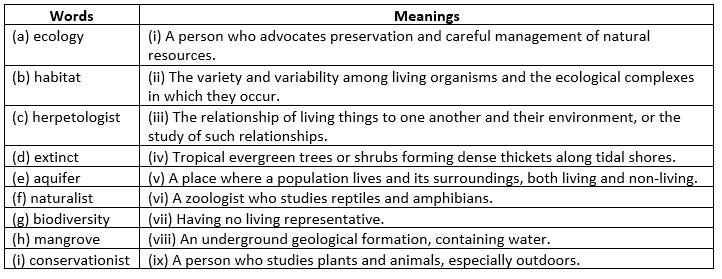 Ans:
Ans:
(a) → (iii)
(b) → (v)
(c) → (vi)
(d) → (vii)
(e) → (viii)
(f) → (ix)
(g) → (ii)
(h) → (iv)
(i) → (i)
B.8. Identify an area in India that needs efforts on a war footing to conserve the bio system. On the model of Wangari Maathai's efforts, prepare in groups a power point presentation covering the environmental problem, causes, effects and solutions. Each student in the group should present a part of the presentation.
Ans: Classroom activity. Students to prepare in groups a power point presentation covering the environmental problem, causes, effects and solution. The following information shall help them a lot in this effort.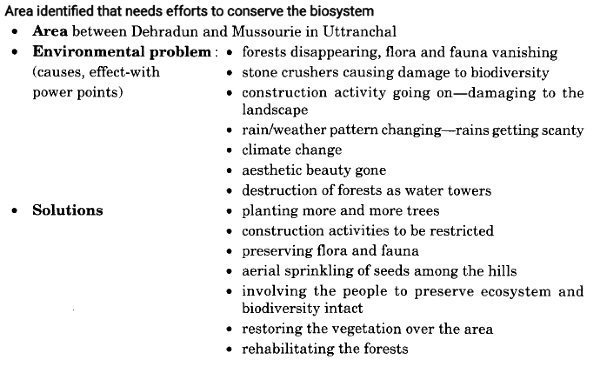
B.9. After reading the interview of Wangari Maathai, you are inspired and motivated to do a summer training under her at one of the Research Stations. Write an email to Wangari Mathai. In your mail describe Wangari's influence on you and your desire to work under her and convince her as to why you should be given a chance to work under her.
Ans:
Date : 24 October, 20 – –
From : praveenl5@gmail.com
To : wangarimaathai@yahoo.com
Subject : Summer Training at a Research Station
Dear Ms Maathai
I am pleased to introduce myself as a great fan of yours. I have read your interview to NHK Radio, Japan and feel greatly inspired. I feel motivated to do a summer training under you at one of the Research Stations.
I am a nature lover and feel greatly pained at the denudation and deforestation almost everywhere. It pains me much to see trees being cut for widening of the roads. It is shocking to see that fertile land is being taken over for commercial purposes. Forests and flora and fauna are disappearing causing weather changes, drop in rainfall and depletion in the ground water table. Wetlands and other water bodies are drying up. I fear for the coming of desertification in areas where there used to be lush green forests once. Not many water harvesting efforts are taken in hands. As a consequence, global warming is showing its painful face. If this goes on, we may soon face the pricking of famines, droughts etc. Food, fodder, fuel, timber wood etc, would not be in plenty. It will result in various problems that might threaten the human life.
I have a keen desire to work under you and to learn how we can rehabilitate the forests and bring back the biodiversity. I personally feel that the scene which you saw before starting your Movement is available here. If we do not take any action, the situation may worsen more. Precisely speaking, I find the force of your movement most appropriate in whatever I wish to do to rehabilitate our environment.
Thanking you
Regards : Yours sincerely
Praveen
|
8 videos|250 docs|8 tests
|
FAQs on Heroes of the Environment NCERT Solutions - Communicative English for Class 10
| 1. What is the main message of the article 'Heroes of the Environment'? |  |
| 2. Who are some notable figures mentioned in 'Heroes of the Environment' and what have they done? |  |
| 3. How can students contribute to environmental conservation as suggested in the article? |  |
| 4. What role does awareness play in environmental conservation according to the article? |  |
| 5. Why is it important to recognize and celebrate 'heroes' of the environment? |  |















